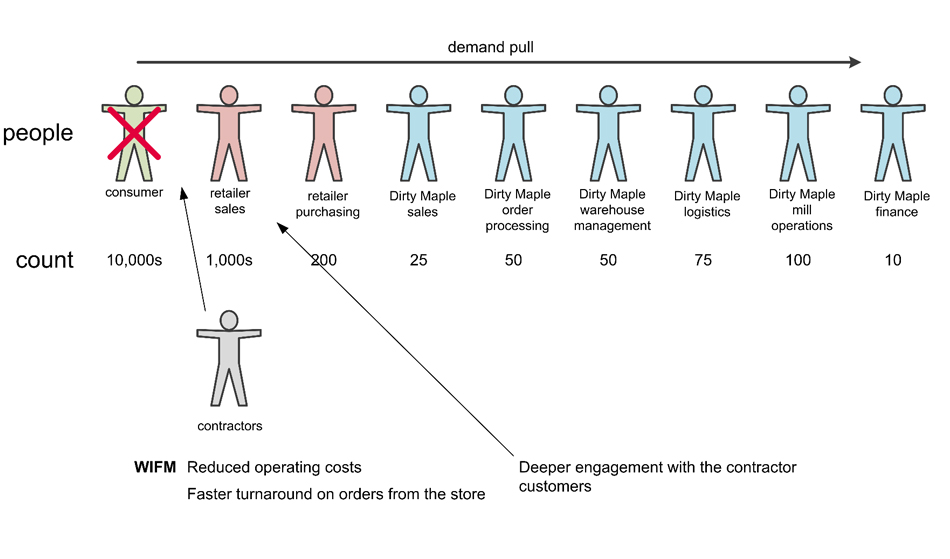By: Doug Collins
Organizations shake and remake themselves to survive and thrive in the Digital Age. What critical conversations need to happen? What processes need to change? How might the practice of collaborative innovation help people find their way forward?
This past fall our columnist the innovation architect Doug Collins began to tell the tale of how the Dirty Maple Flooring Company came to embrace the Digital Age through the practice of collaborative innovation. The latest episode appears below. Readers may navigate the full series here.
An Interlude in Which the Author Offers a Singular Observation
The Digital Age comes to us bearing the gifts of transparency and immediacy. Mindful execution, emboldened by authentic leadership, becomes our differentiator.
Yerba Mate Inspiration: Charlie Bangbang Seeks the Ground Truth
“What do you think, Luiz? Will your store participate?”
“Yes, of course, Charlie. Por quo nao?”
Charlie, Ivete, and Luiz stood in the anteroom of Luiz’s flooring and cabinetry store in Fortaleza. A breeze, carried unknowable distances across the Atlantic, made its way up Avenue Jose Bastos and dispersed itself among the people congregating on the main floor of the showroom. The sound of high heels treading the cherry parquet floor lent an uneven beat to the floor sales patter.
Some days, Charlie wondered whether he should be writing a check to Dirty Maple for the privilege of working there. The global economy, like the ocean, could be unrelentingly brutal. It could, on a fair day, be sublime.
“However, Charlie, “ Luiz continued, “I might suggest that we invite the owners of our top five contractors to participate in your innovation challenge, too. You see, for the product lines that you offer, most the customers have the flooring and cabinetry installed by contractors, as opposed to installing it themselves. In some ways, these contractors operate as mini retailers. They carry a small amount of inventory for their jobs. They carry cash balances with us. They would be motivated to remove waste, as you call it, from the process, just as we would.”
“Excuse me for a second, Luiz,” Ivete said. Charlie and she exited the store, turned right, and ambled towards the art museum.
“What do you think, Ivete?” Charlie asked.
“Well, Charlie, he’s got a point. We said we don’t want to include the end consumer in the first challenge. That makes sense. Why would they care? But the contractors are a special case. They are our customers’ customers—for us, at least, in many cases—and they are also businesses in their own right—not families buying the hardwood for their homes and apartments.”
“You are the country manager here, Ivete. Do you have qualms about including them? You know the contractors rep our competitors’ products, too. From what I can see, they tend to promote three or four lines with their customers. Nobody enjoys exclusivity.” Charlie watched a group of students wearing the bright yellow of the national futbol team make their way to the beach.
“Charlie, I think it is okay. Really, I do. Luiz and I go back a long, long way. Do you know that we both grew up around Cascarel to the south of here? Anyway, we talk. We talk. Luiz tells me that his contractor customers are moving in two different directions as our market matures and more money starts to flow into the coastal regions from our own people making good and the European retirees—the Portuguese and Italians, mainly. One group is steadily moving up market, as is Luiz. They tend to build demand based on their reputation for providing quality service and support. They find they can charge a little more. The margins help them ride out the down cycles. The other group continues to sell strictly on price. They compete not so much with one another, but with the do-it-yourself alternative. They also tend to come and go more often, given their margins are so thin.”
“Luiz and I predict a further shake out among these contractors as the country develops. It would be in our best interest to get closer to the larger contractors working on the higher end. And, keep in mind, these are the same guys who will be the first to open their own retail stores if they can get their hands on enough capital. Better that we get to know them now.”
“Are we making a deal, Ms. Monte? Quid pro quo?”
“Sim, estamos, Charlie!”
Ivete and Charlie entered the pedestrian mall near Jose de Alencar Park. They walked past the colonial facades to a café, its doors open to take in the cooling ocean air. Ivete ordered two yerba mates for them. Charlie sucked on his straw as he extended his value stream map of the challenge community from his portfolio. Ivete saw him scribble with his pencil. He handed her a marked up view of his map (figure 1). (Original view appears in part six.)
Figure 1: Charlie and Ivete update their view of the collaborative innovation community

“What does WIFM mean, Charlie? I do not know this word.”
“WIFM? It means What’s In It For Me. WIFM. We use the term in the states when we try to put ourselves in the shoes of the other guy. I am finding that by combining the value stream with the WIFM layer, I can check whether the community make up makes sense. Will it work? Will people engage? Why?”
“Sounds good, Charlie” Ivete stared at the ocean.
From where they sat, she could see the blue of the water and the green fringe of the top of the palm trees that Fortaleza’s parks department planted a couple years ago after the last big storm. She was happy to see Charlie engaged in and enjoying his work. His ability to focus had impressed her, always.
She wondered, too, whether his focus served as a high, high wall to keep memories of Jane at bay—at least during the hours of daylight, when the past retreated to let the present run its course.
About the author

Doug Collins serves as an innovation architect. He helps organizations such as The Estee Lauder Companies, Jarden Corporation, Johnson & Johnson, The Procter & Gamble Company, and Ryder System navigate the fuzzy front end of innovation.
Doug develops approaches, creates forums, and structures engagements whereby people can convene to explore the critical questions facing the enterprise. He helps people assign economic value to the ideas and to the collaboration that result.
As an author, Doug explores ways in which people can apply the practice of collaborative innovation in his series / Innovation Architecture: A New Blueprint for Engaging People through Collaborative Innovation. His bi-weekly column appears in the publication Innovation Management. Doug serves on the board of advisors for Frost & Sullivan’s Global community of Growth, Innovation and Leadership (GIL).
Today, Doug works as senior practice leader at social innovation company Mindjet, where he consults with a range of clients. He focuses on helping them realize their potential for leadership by applying the practice of collaborative innovation.
Photo: Yerba mate caps from shutterstock.com

